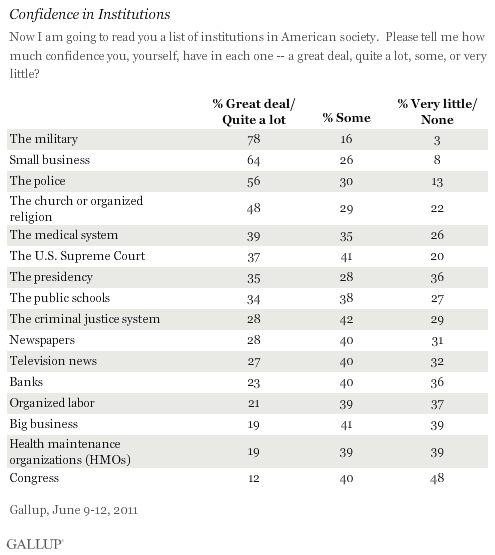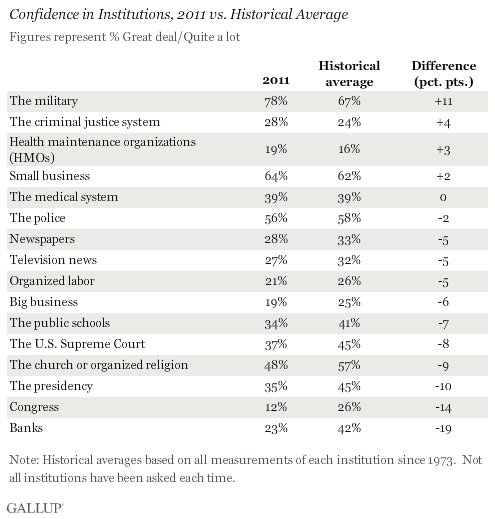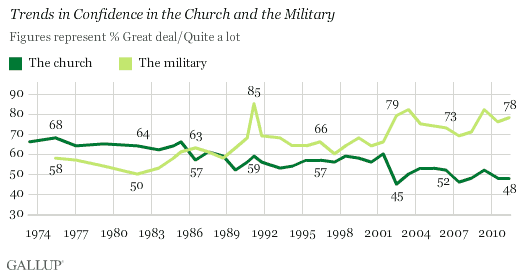PRINCETON, NJ -- Americans continue to express greater confidence in the military than in 15 other national institutions, with 78% saying they have a "great deal" or "quite a lot" of confidence in it. In addition to the military, a majority of Americans express high esteem for small business and the police. Congress ranks last among these institutions, behind big business and health maintenance organizations.

Gallup has asked Americans to say how much confidence they have in a variety of U.S. institutions a total of 35 times since 1973, including annual updates since 1993. This year's results are based on a June 9-12 Gallup poll.
Little has changed in Americans' confidence in institutions over the past year. The only notable difference was a significant increase in Americans' confidence in television news, from 22% to 27%. There was also a slight, but not statistically meaningful, increase in confidence in newspapers (from 25% to 28%). Confidence in the police is down 3 percentage points, a change that is also within the poll's margin of sampling error.
In a year in which labor unions have been in the news for public employee union battles with state governments over benefits and bargaining rights, Americans' confidence in organized labor did not change (20% in 2010 vs. 21% in 2011).
Confidence in Military Bucks Larger Trend in Declining Confidence
From a broader perspective, confidence in most of the institutions this year is below the historical average for each. These depressed figures likely reflect Americans' current dissatisfaction with the way things are going in the country, in large part due to the state of the economy. This year's ratings of banks, Congress, and the presidency are the most below their historical average.

The most notable exception to the general pattern of lower confidence is for the military, whose 78% reading this year is 11 points higher than its historical average. Americans tend to express much greater confidence in the military when the U.S. is actively engaged in military operations, as in an 85% rating in Feb.-March 1991 just after the first Persian Gulf War ended and ratings between 69% and 82% over the last decade coinciding with U.S. military action in Afghanistan and Iraq.
The military has been the top ranked institution each year since 1998 and from 1989 to 1996. In 1997, when small business was added to the survey for the first time, it edged out the military by 63% to 60%.
The church or organized religion was the top institution in the eight measurements conducted from 1973 through 1985. Confidence in the church declined in 1986, with the military surpassing it in confidence that year for the first time. Confidence in the church has yet to return to its pre-1986 levels.

Forthcoming articles on Gallup.com will review the trends for several of these institutions in greater depth. The full trends for each institution are available here.
Survey Methods
Results for this Gallup poll are based on telephone interviews conducted June 9-12, 2011, with a random sample of 1,020 adults, aged 18 and older, living in all 50 U.S. states and the District of Columbia.
For results based on the total sample of national adults, one can say with 95% confidence that the maximum margin of sampling error is ±4 percentage points.
Interviews are conducted with respondents on landline telephones and cellular phones, with interviews conducted in Spanish for respondents who are primarily Spanish-speaking. Each sample includes a minimum quota of 400 cell phone respondents and 600 landline respondents per 1,000 national adults, with additional minimum quotas among landline respondents for gender within region. Landline telephone numbers are chosen at random among listed telephone numbers. Cell phone numbers are selected using random-digit-dial methods. Landline respondents are chosen at random within each household on the basis of which member had the most recent birthday.
Samples are weighted by gender, age, race, Hispanic ethnicity, education, region, adults in the household, and phone status (cell phone only/landline only/both, cell phone mostly, and having an unlisted landline number). Demographic weighting targets are based on the March 2010 Current Population Survey figures for the aged 18 and older non-institutionalized population living in U.S. telephone households. All reported margins of sampling error include the computed design effects for weighting and sample design.
In addition to sampling error, question wording and practical difficulties in conducting surveys can introduce error or bias into the findings of public opinion polls.
View methodology, full question results, and trend data.
For more details on Gallup's polling methodology, visit www.gallup.com.

